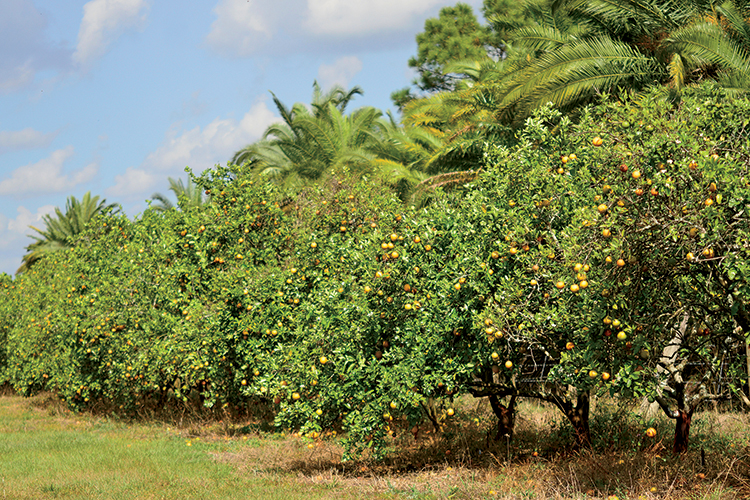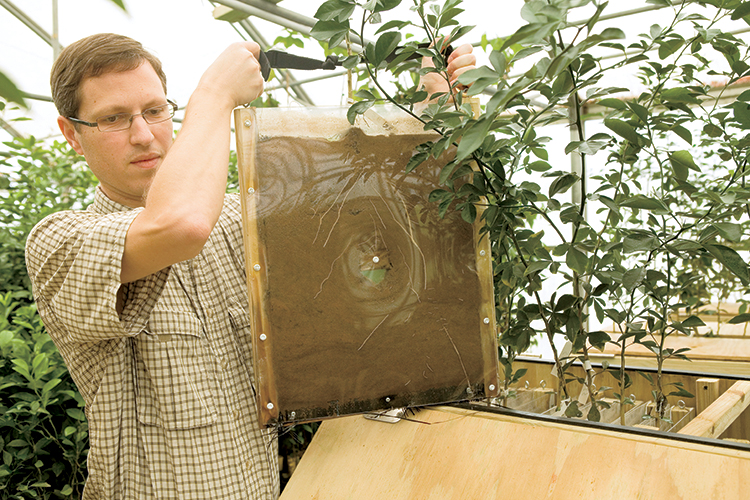Home > Florida > Florida Crops & Livestock > Florida Citrus Maintains the Juice
Florida Citrus Maintains the Juice
In partnership with: Florida Department of Agriculture and Consumer Services

When it comes to advancing the state’s citrus industry, the University of Florida Institute of Food and Agricultural Sciences (UF/IFAS) leads the way.
At the UF Citrus Research and Education Center in Lake Alfred, a staff of more than 200 employees, propels the state’s citrus industry forward through research performed in greenhouses, more than 600 acres of groves, a juice processing plant, a fresh fruit packing house and more than 40 laboratories.
UF/IFAS research findings have helped Florida remain a leader in the citrus industry, accounting for 69 million citrus trees grown on more than 524,500 acres throughout the state. This represents approximately 65 percent of the country’s total citrus production, which brings in about $9.5 billion to the state.
Research Success
In one UF/IFAS study, agricultural and biological engineering professor Wonsuk “Daniel” Lee discovered an algorithm to find immature citrus in photos taken under different light conditions and fruit that was hidden by leaves and branches.
An 80 percent accuracy rate means growers can use the model to know well before harvest how much fruit is on their trees, and better plan for harvesting, predict crop yields and possibly increase yield.
The findings are part of Lee’s research goal of developing an electronic system that can “see” and count fruit, a concept called machine vision.
Over the past few years, UF/IFAS scientists have focused their research on citrus greening (officially called Huanglongbing or HLB), one of the most serious diseases that can affect citrus trees.
Researchers have been working on solutions from mapping the citrus genome and pinpointing the bacterial cause of the disease to developing resistant rootstock, leading the way to a long-term solution. They have also focused on developing nutritional and pesticide spray treatment protocols to reduce the spread of the disease.
Though there is still more to be done, UF/IFAS researchers have made several important steps forward in the search for a solution.

Grower Appreciation
Dan Richey, CEO of Riverfront Groves in Vero Beach, grows citrus on 4,000 acres in Indian River and St. Lucie Counties.
The largest packer of grapefruit in the state, Richey notes while citrus greening is absolutely the industry’s biggest challenge, and the root of a great amount of angst and concern, he cannot deny the progress that has been made.
“If we step back and evaluate where we are today in our fight against greening versus where we were two to three years ago, we will recognize the great progress we have made,” Richey says. “We will meet and defeat this challenge. It will be accomplished due to the herculean efforts of many. We are deploying an unprecedented sum of money and scientific brainpower to bring about a solution.”
As executive vice president of the Gulf Citrus Growers Association, Ron Hamel leads the 200-plus citrus growers in Southwest Florida’s Gulf Production Region. He has been impressed lately with the implementation of new research findings by his growers, which account for about 25 percent of the state’s total citrus industry.
“Some major citrus growers are replanting thousands of acres of new citrus trees and treating them based on the latest scientific production technologies,” he says.
Working Beyond Citrus
More than just citrus, the UF/IFAS research team helps all of Florida’s producers immensely.
The Tropical Aquaculture Laboratory in Ruskin is dedicated exclusively to aquaculture, where experts conduct research and outreach programs to help producers provide better environmental conditions, nutrition and health care to fish and other organisms.
Alan Hodges, extension scientist and director of economic impact analysis program at UF/IFAS says the center has also played a pivotal role in Florida’s booming blueberry industry. They developed and released southern highbush cultivars that ripen in late April and May, a time when few blueberries are available and market prices are high.
Since 2005, nearly all blueberries planted in the state are comprised of highbush cultivars from UF/IFAS. Varieties created by UF/IFAS dominate the strawberry and tomato industries, as well.
Hodges also mentions the Florida Agricultural Weather Network, or FAWN.
“This program enables more accurate forecasts of local weather conditions, helping growers to protect crops during freezes, and conduct more accurate assessment of irrigation needs,” he says.




